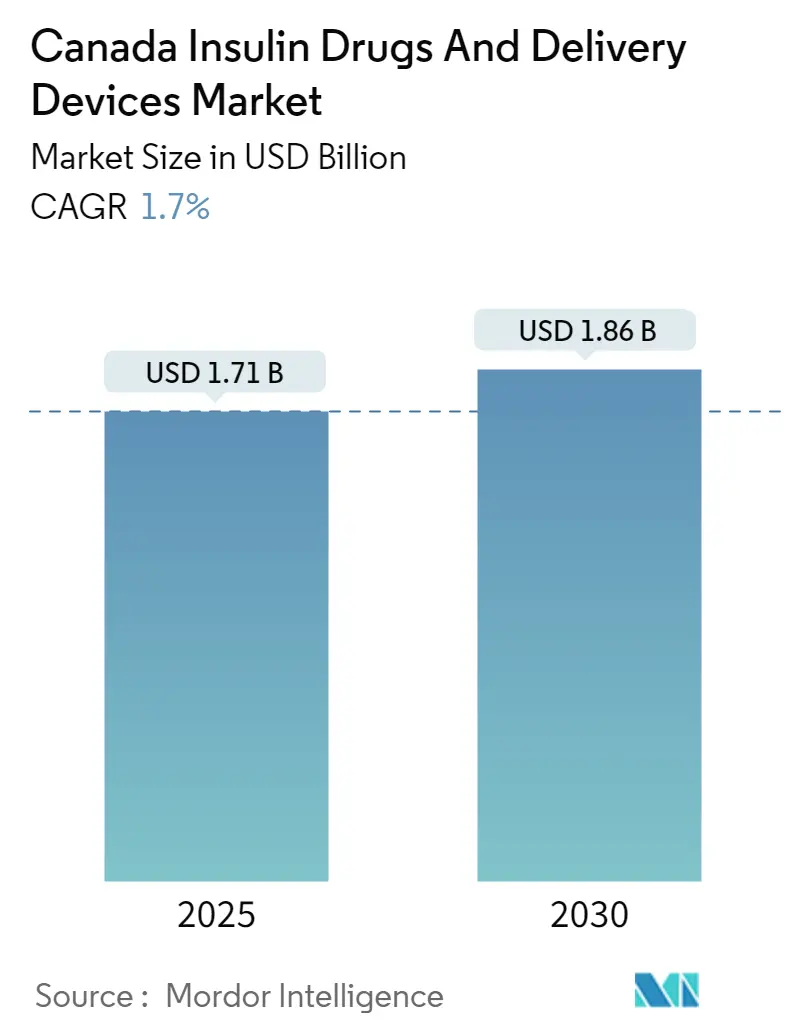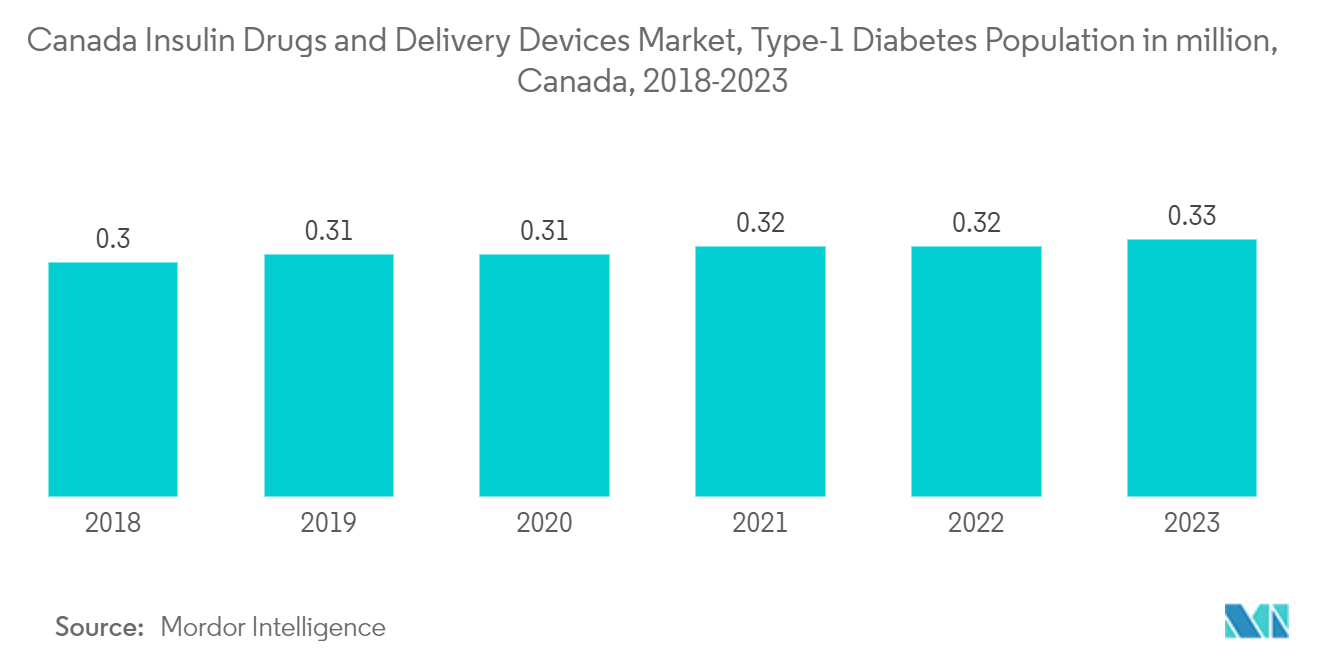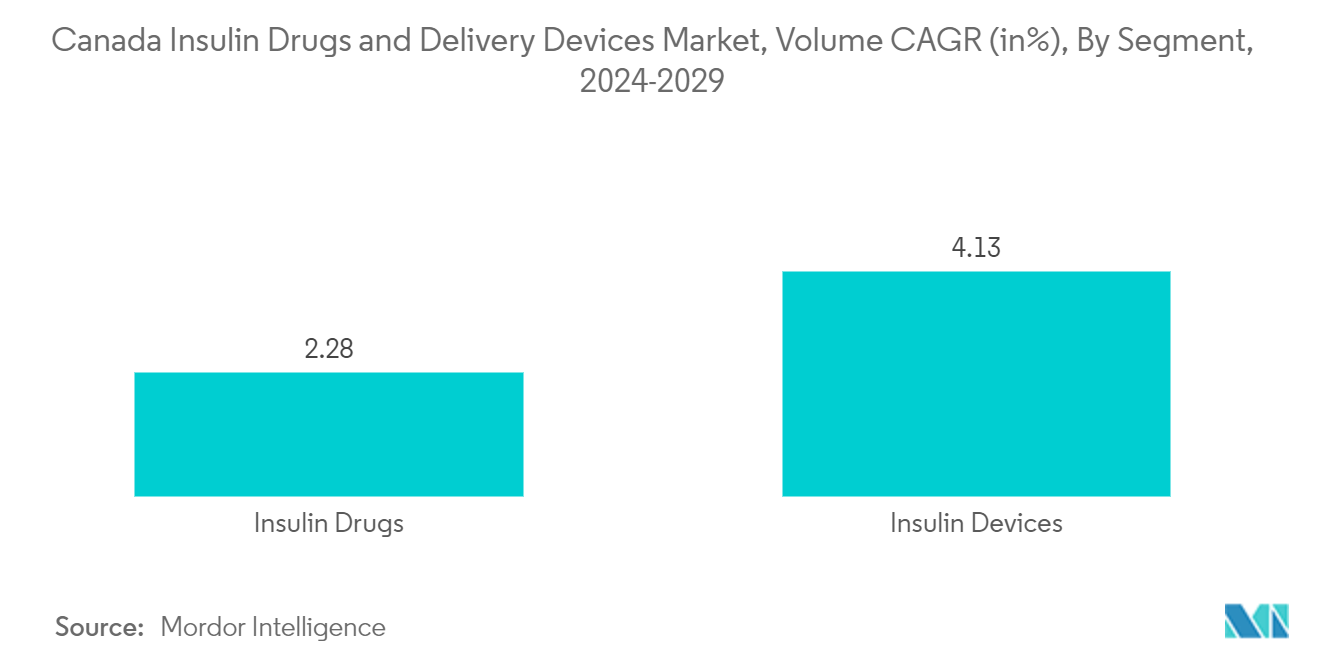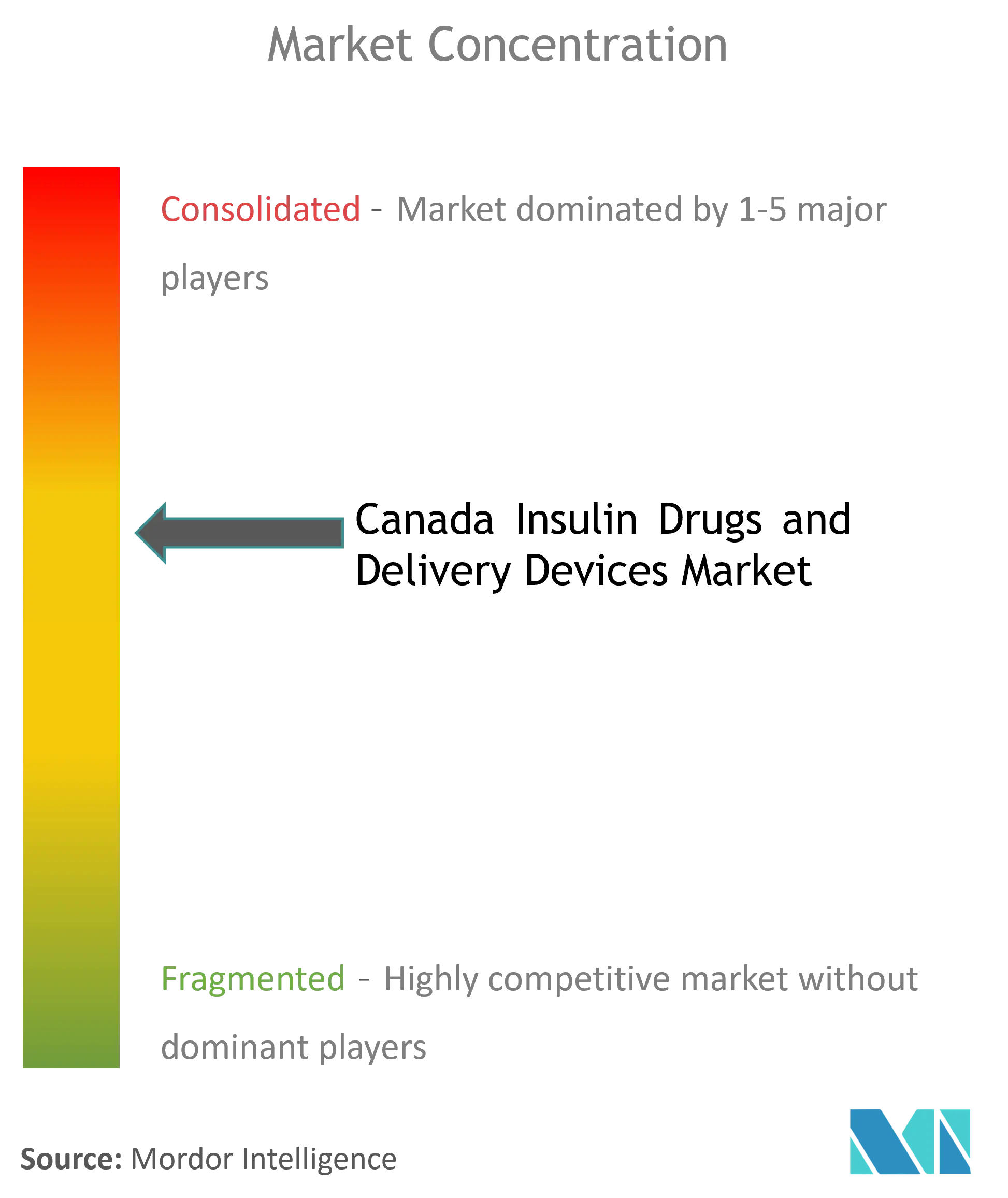
Canada Insulin Drugs And Delivery Devices Market Analysis
The Canada Insulin Drugs And Delivery Devices Market size is estimated at USD 1.71 billion in 2025, and is expected to reach USD 1.86 billion by 2030, at a CAGR of 1.7% during the forecast period (2025-2030).
In Canada, however, a vial of insulin costs less than USD 50. People looking for cheaper insulin are increasingly flying north from all over the United States to stock up. Although it is technically illegal to import unapproved drugs from Canada, regulators usually do not object to patients looking to save money while on vacation. According to the FDA's website, people importing less than a three-month supply of a drug for personal use "typically do not object."
Canada Insulin Drugs And Delivery Devices Market Trends
Growing Diabetes and Obesity Population in Canada
The (CDC) Centers for Disease Control and Prevention stated that smokers are 30 - 40 percent of getting diabetes later in life. These facts were later supported by a study in 2019 which stated that cigarette smoking is one of the reasons for the high cases of diabetes patients in the same year. Diabetes Canada is dedicated to assisting patients in lowering their risk of complications and improving their health outcomes by advocating for access to evidence-based, personalized diabetes treatments such as biologic drugs and biosimilar insulins.
Diabetes Canada is pleased that biosimilar insulins provide additional treatment options for people with diabetes and may be the preferred option for some. However, we believe that the decision to use a biological drug or biosimilar insulin should be made collaboratively by diabetes patients and their healthcare providers.
Diabetes prevalence has increased significantly in Canada over the last few decades, as have healthcare costs. Funding decisions for health systems and services are increasingly being made in a fiscally constrained environment. There must, however, be a balance. Despite financial constraints, patients must remain at the center of health policy decisions.
Diabetes patients should be assisted in reaching their full health potential, with appropriate consideration given to the cost of doing so. With this in mind, insulin-naive patients can be encouraged to begin treatment with biosimilar insulin. Non-medical switching happens when a patient's medical treatment is changed for reasons other than health and safety.
Leading manufacturers focus on technological innovations and develop advanced products to gain a substantial market share. There has been a significant rise in insulin delivery systems technology, from insulin injections to insulin pumps. Technological innovations and advancements offer many conveniences in maintaining blood glucose levels.
Therefore, owing to the increasing diabetes prevalence, the studied market is anticipated to grow over the analysis period.

The Insulin Pumps Segment is Expected to Witness Highest Growth Rate Over the Forecast Period
An insulin pump is a device that delivers insulin continuously or, whenever required, automatically. The pump mimics the human pancreas. The insulin infusion pump works as an alternative to the traditional system of daily injections or an insulin pen.
Insulin Pump held a major market share in the insulin delivery devices market in the current year and is expected to grow with a CAGR of more than 4.3% during the forecast period because of the increasing technological advancement and its preference over other traditional methods due to continuous insulin administration. Insulin pump therapy is a well-established insulin administration method for type 1 diabetes (T1DM) people. Pumps are a validated, time-tested therapeutic option in T1DM at all ages, enabling near-physiological insulin delivery in situations where the pancreas does not produce insulin.
There are even pump models with remote controls enabling parents of young children to either suspend or bolus insulin from a distance when the child is playing or eating. The insulin infusion pumps reduce the large swings in blood glucose levels, induce less pain, and deliver more accurately when compared to injections. These advantages of insulin pumps over the traditional delivery system are expected to boost the market.
Canadians living in provinces with limited coverage or not meeting eligibility criteria for their provincial plan must pay out-of-pocket for insulin pump therapy, which carries a USD 6,000 to USD 7,000 price tag. In addition, the ongoing expense of monthly supplies is a constraint to the use of insulin pumps, costing up to USD 300 every month. For many people, these charges are prohibitive. Restricted access means a lost opportunity for people with type 1 diabetes to enhance their glucose management and diabetes-specific quality of life and treatment satisfaction.
Diabetes Canada recommends that provincial governments remove age discrimination and other financial and administrative barriers to accessing the insulin pump program to make pump therapy available to all clinically eligible people with type 1 diabetes. Pump supplies must be covered for all products required to use an insulin pump, including antiseptic, adhesive, and protective barrier products. When governments use co-pays and mean testing, the test criteria must be set at a level that ensures the cost of diabetes care is not a barrier or burden to the individual. People living with diabetes in Canada should also have access to the education and support they need to effectively manage their disease.

Canada Insulin Drugs And Delivery Devices Industry Overview
The Canada Insulin Drugs and Delivery Devices Market is consolidated, with few significant and generic players. Mergers and acquisitions that happened between the players in the recent past have helped the companies strengthen their market presence. Eli Lilly and Boehringer Ingelheim have an alliance in developing and commercializing Basaglar (Insulin Glargine). Additionally, the players in the recent past helped the companies strengthen their market presence; for example, Novo Nordisk collaborated with Ypsomed to provide better insulin therapy solutions.
Canada Insulin Drugs And Delivery Devices Market Leaders
-
Roche
-
NovoNordisk
-
Sanofi
-
Medtronics
-
Eli Lilly
- *Disclaimer: Major Players sorted in no particular order
Canada Insulin Drugs And Delivery Devices Market News
- May 2024: Health Canada has approved for the use of the Medtronic Guardian 4 CGM sensor with the MiniMed 780G. The approval from Health Canada follows the FDA's authorization of the MiniMed 780G with Guardian 4. When operating in SmartGuard mode, the system eliminates the need for fingersticks. It is equipped with meal detection technology that automatically makes adjustments and corrections to blood sugar levels every five minutes, catering to both basal (background) and bolus (mealtime) insulin requirements.
- November 2022: Medtronic Canada announced that it had received a license from Health Canada for its MiniMed 780G system for people with type 1 diabetes. This system with the advanced hybrid closed loop is Canada's first and only insulin pump system that can automatically adjust and correct sugars every 5 minutes.
Canada Insulin Drugs And Delivery Devices Industry Segmentation
Insulin pens are equipped with preloaded insulin to administer insulin injections. Various types of insulin pens, such as "smart" or connected ones, are available in the market. Your healthcare provider will provide detailed instructions on how to effectively utilize these pens. Canada's Insulin Drugs and Delivery Devices Market is segmented into Drugs and devices. The report offers the value (in USD) and volume (in Units) for the above segments.
| Drug | Basal or Long-acting Insulins | Lantus (Insulin Glargine) | |
| Levemir (Insulin Detemir) | |||
| Toujeo (Insulin Glargine) | |||
| Tresiba (Insulin Degludec) | |||
| Basaglar (Insulin Glargine) | |||
| Bolus or Fast-acting Insulins | NovoRapid/Novolog (Insulin aspart) | ||
| Humalog (Insulin lispro) | |||
| Apidra (Insulin glulisine) | |||
| FIASP (Insulin aspart) | |||
| Admelog (Insulin lispro Sanofi) | |||
| Traditional Human Insulins | Novolin/Mixtard/Actrapid/Insulatard | ||
| Humulin | |||
| Insuman | |||
| Combination Insulins | NovoMix (Biphasic Insulin aspart) | ||
| Ryzodeg (Insulin degludec and Insulin aspart) | |||
| Xultophy (Insulin degludec and Liraglutide) | |||
| Soliqua/Suliqua (Insulin glargine and Lixisenatide) | |||
| Biosimilar Insulins | Insulin Glargine Biosimilars | ||
| Human Insulin Biosimilars | |||
| Device | Insulin Pumps | Insulin Pump Devices | |
| Insulin Pump Reservoirs | |||
| Insulin Infusion sets | |||
| Insulin Pens | Cartridges in reusable pens | ||
| Disposable insulin pens | |||
| Insulin Syringes | |||
| Insulin Jet Injectors | |||
Canada Insulin Drugs And Delivery Devices Market Research FAQs
How big is the Canada Insulin Drugs And Delivery Devices Market?
The Canada Insulin Drugs And Delivery Devices Market size is expected to reach USD 1.71 billion in 2025 and grow at a CAGR of 1.7% to reach USD 1.86 billion by 2030.
What is the current Canada Insulin Drugs And Delivery Devices Market size?
In 2025, the Canada Insulin Drugs And Delivery Devices Market size is expected to reach USD 1.71 billion.
Who are the key players in Canada Insulin Drugs And Delivery Devices Market?
Roche, NovoNordisk, Sanofi, Medtronics and Eli Lilly are the major companies operating in the Canada Insulin Drugs And Delivery Devices Market.
What years does this Canada Insulin Drugs And Delivery Devices Market cover, and what was the market size in 2024?
In 2024, the Canada Insulin Drugs And Delivery Devices Market size was estimated at USD 1.68 billion. The report covers the Canada Insulin Drugs And Delivery Devices Market historical market size for years: 2019, 2020, 2021, 2022, 2023 and 2024. The report also forecasts the Canada Insulin Drugs And Delivery Devices Market size for years: 2025, 2026, 2027, 2028, 2029 and 2030.
Our Best Selling Reports
Canada Insulin Drugs And Delivery Devices Industry Report
Statistics for the 2025 Canada Insulin Drugs And Delivery Devices market share, size and revenue growth rate, created by Mordor Intelligence™ Industry Reports. Canada Insulin Drugs And Delivery Devices analysis includes a market forecast outlook for 2025 to 2030 and historical overview. Get a sample of this industry analysis as a free report PDF download.




